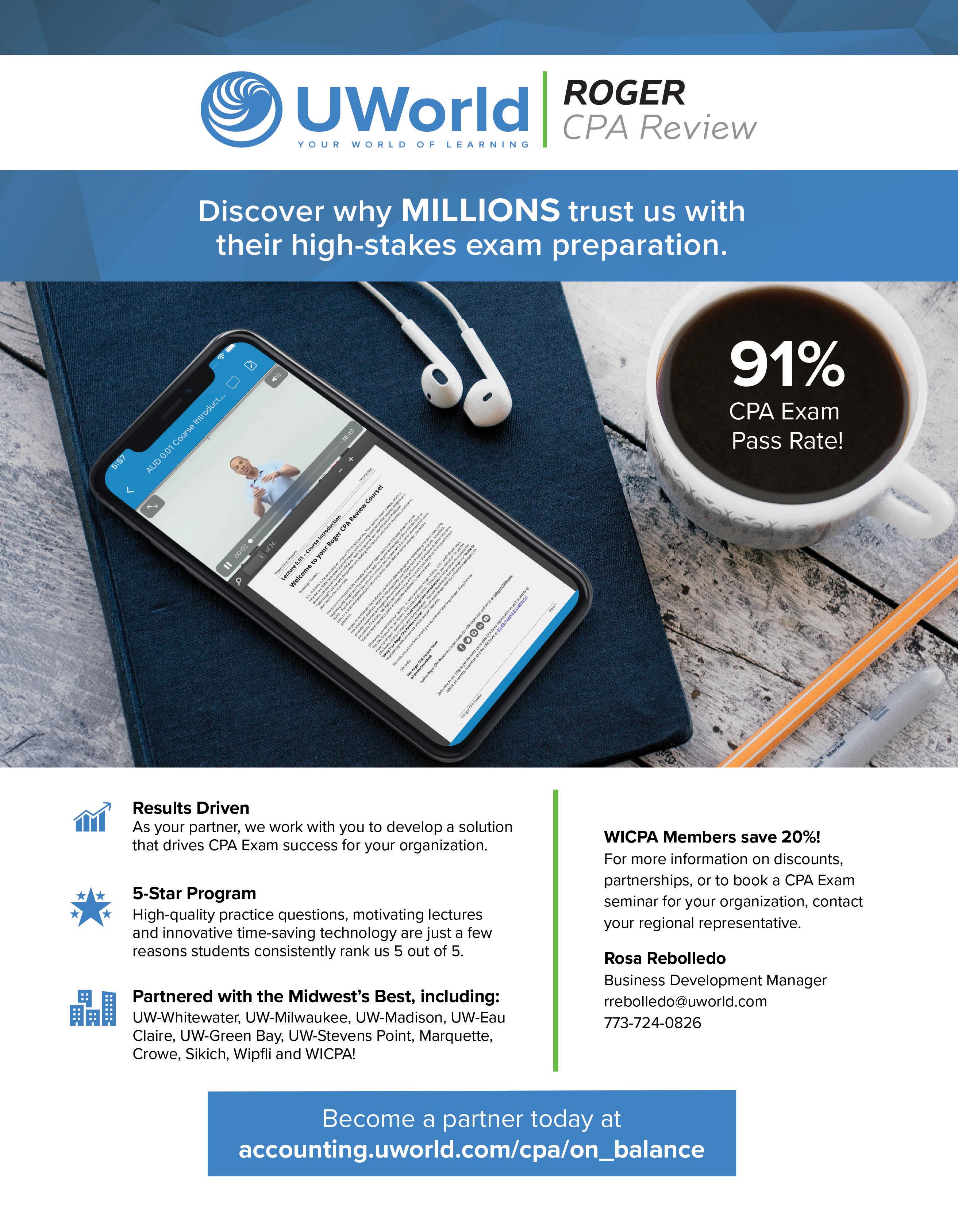
9 minute read
TECHNOLOGY
TECHNOLOGY TOOLS CHANGE WITH THE TIMES
Are you doing things the same old way? Do you wish there were an easier way? Have you noticed how rapidly our technology tools are changing? Continuous updates via the internet have become the standard for technology on our
By Randy mobile phones, for Software as a
Johnston Service (SaaS) and for applications like Microsoft Office. Addressing security needs, learning new features and evolving the product can’t be a once-a-year process, releasing all the changes at one time using the waterfall approach. Developers are using short sprints spanning just a few weeks to add features and repair

bugs while following the “scrum” approach — a structured framework for product development that is frequently used by agile software development teams.
How do you accommodate rapid change?
First, you need to have your own vision. What are your business strategy and tactics, and what are your information technology (IT) strategy and tactics? How do you build your business case for the use of any technology, and how do you justify your expenditures? How do you manage change? What do you have in place for governance of the changes? Or do you simply “decide”? Second, you need to pick tools from the software creator that work together or that have an automated way to connect with software tools we call digital plumbing, or you have to have available IT expertise in-house or
contracted to keep the tools running. In the CPA firm world, we attempted to work around most of these problems by picking all our applications from a single vendor like CCH Wolters Kluwer or Thomson Reuters. This approach is commonly referred to as the “one-suite” method. Our expectation was that these vendors would make all their modules work together or “talk” to each other, so a client set up in practice management would flow into the tax software. We had a similar expectation when we purchased software from a major vendor like Sage Software, which had lots of modules that they owned and sold. However, by the time we reached the early part of this century, it was clear that integrations to third-party vendors were going to become more common. Today, most vendors don’t build a complete solution. They expect you to acquire all the thirdparty applications you need to solve your business issues. This approach is commonly referred to as the “best-ofbreed” method. As a business manager, you must assume that your applications will change regularly, probably even monthly. This is quite different from the past, when applications had major revisions once or twice a year with the waterfall method of releases. You will need to have training for your team to accommodate the rapid change. Most users do not have the desire, time or insight to recognize new software features and optimize the way they use them. Worse, many do not even notice that a new feature has arrived. For best results, we believe your business should map all the processes used. When software is updated, these processes can change for better or worse. You need to make sure your team understands the changes and what the firm believes is the best method to use the software to run the business smoothly. Further, vendors will try to sell additional applications and features that you may or may not need. Consider how you will evaluate the opportunities presented continuously by new software and features. Not all problems should be solved with technology, but not using features that you are already paying for seems like a waste of human capital. As examples, consider the use of Excel Tables; the Excel Data Model along with the Extract, Transform and Load features of Get Data; or the use of certification in Adobe Acrobat. All these features have been available for years, and we suspect many of you do not know they exist.
How can I help my team?
Education and training! When choosing your continuing professional development courses, remember that learning

new time-saving techniques is important. Education shows the big picture and helps you understand strategy, while training instructs on how to complete a simple task. While just-in-time learning is convenient to help solve a pressing problem, the technique learned may not be the optimal way or even the way you want the problem solved. On the other hand, the user may have spotted a new, easier way to complete critical tasks. You should learn from the user (or the user from you), your processes should be updated, and the new method should be taught to everyone. As a business manager or owner, one of your jobs is to help people be as effective as possible and do their work in the most optimal way. Human nature tells us to do things in the easiest way possible, and technology can help us do that. However, that desire to do things in an easy way is often offset by resistance to change. You can achieve the best of all worlds if you can help people change by optimizing their processes and making things easier. However, this is not a “one and done.” While we used to recommend process revisions twice a year, the software updates that are changing almost monthly tell us that processes need to be revised more often — perhaps monthly. As you learn the optimal way to revise your processes, we’d love to hear about it.
Randy Johnston is executive vice president of K2 Enterprises, where he develops and delivers technology-focused learning opportunities for accounting, financial and other business professionals. Contact him at randy@k2e.com.
Victor E. Bethke, CPA (1950 – 2020) Victor E. Bethke, CPA, 70, of Augusta, passed away Friday, Feb. 21. Bethke was born in Eau Claire and raised on the family farm south of Augusta in Bridge Creek Township. He graduated from Augusta High School in 1968 and subsequently earned a bachelor’s degree in accounting from UW–Eau Claire. As a new CPA, he worked for an accounting firm in Stevens Point for five years before starting his own firm, Bethke & Associates, in Plover, where he worked for 25 years before retiring in 2005. Bethke is survived by his wife of 49 years, Jennifer; two brothers and five sisters; and several nieces and nephews.
Gail A. Daugherty, CPA (1957 – 2019) Gail Daugherty, CPA, died suddenly on Thursday, Feb. 27, at her Menomonee Falls home. The 1975 graduate of New Berlin West High School earned a degree in accounting from UW–Madison in 1979 and became a CPA in 1983. She began her years in business with the national firm of Coopers & Lybrand and then worked with Strong Capital Management in Menomonee Falls. Daugherty’s last years were spent with Crabel Capital Management in Milwaukee; she retired in 2017. She is survived by her mother, a brother and sister-in-law, one nephew and many other friends and relatives.

David B. Gerstner, CPA (1954 – 2020) David B. Gerstner, CPA, passed away Sunday, July 19. He was 65. A Green Bay native, Gerstner was a graduate of Preble High School and attended UW–Whitewater, where he earned a degree in accounting. He ultimately became a licensed CPA and was a partner at a public accounting firm until January 2008, when he became president and CEO of De Pere Cabinet Inc., where he remained until his health would not allow him to continue. Gerstner was a longstanding member of the National Railroad Museum board of directors, serving as their treasurer, and also participated with the Humane Society and Family Services, among other organizations. He is survived by his wife, Maryanne; two daughters; four grandchildren; one brother and two sisters; and numerous other relatives and friends.
Lisa E. Kuenn, CPA (1971 – 2020) Lisa Kuenn, CPA, passed away Wednesday, March 11, at age 48. Kuenn was a successful accountant who several years ago became a partner with Andoloro, Smith & Krueger LLP in Waukesha. She is survived by her husband of 20 years, Rob; a daughter, Cassie; both parents; a sister and nephew; and many other relatives and friends. Thomas J. Milliken, CPA (1956 – 2020) Thomas J. Milliken, CPA, 63, passed away from natural causes on Friday, March 20. He was a longtime resident of Madison but was currently residing in Rio Verde, Arizona. He is survived by his wife, Patricia; one son and one daughter; and four siblings. A celebration of life will be held at a later date, at which time a full obituary will be published online.
Thomas P. Moore, CPA (1936 – 2020) Tom Moore, CPA, of Monona, passed away Saturday, May 30, at age 83. Moore graduated from UW–Madison in 1958 and became a CPA. He spent his entire career with Smith & Gesteland CPAs and was promoted to partner in 1967. After he retired, Moore returned to UW–Madison and earned a degree in Community and Environmental Sociology; he then volunteered at the Monona Grove High School Student Services Center, Dane County 4H and the Wisconsin headquarters of the USDA’s Natural Resources Conservation Service. Moore is survived by his wife, DeAnn; six children; and many grandchildren and great-grandchildren.
Edward H. “Tadd” Trier III, CPA, CGMA (1959 – 2020) Tadd Trier, CPA, CGMA, of River Hills, passed away Thursday, April 9, at the age of 60. Trier graduated from Homestead High School in 1977 and earned a Bachelor of Science degree in accounting from Upper Iowa University. He started his career with Ernst & Young and worked as a CPA in both the private and public sectors of accounting before becoming a partner and president of the firm of Milkus, Trier & Company in West Bend. Trier attended Fox Point Lutheran Church and was a dedicated board member of Faith Walkers Men’s Group in Brown Deer. He is survived by his wife, Brenda; his mother, Toni; four siblings; aunts, uncles, nieces and nephews; and many colleagues and friends.
Donald S. Wagner, CPA (1931 – 2020) Don Wagner, CPA, a longtime WICPA member, died Monday, May 4, at age 88. Wagner served in the U.S. Army from 1952 to 1954, stationed in Germany. After discharge, he earned a degree from Badger Business College and became a CPA, gaining employment with the firm of Schuldes, Burns, Alk and Denis in Green Bay. Eventually, he joined Wipfli LLP and retired from that firm in 1992. Wagner was very active with the WICPA and the AICPA and served as president of the WICPA board of directors in 1992–1993. In 1995, he received the WICPA’s Distinguished Career Award. Wagner served his community as a member and officer of the Thursday Breakfast Optimist Club, the Cerebral Palsy Foundation, and Boys and Girls Clubs of Greater Green Bay. He is survived by his son and daughter, four grandchildren, three great-grandchildren and many other relatives and friends.
If you are aware of a member obituary and believe it should be included in Memorials, please send a copy of the obituary or contact Marcia Tillett-Zinzow at mtzinzow@icloud.com.









